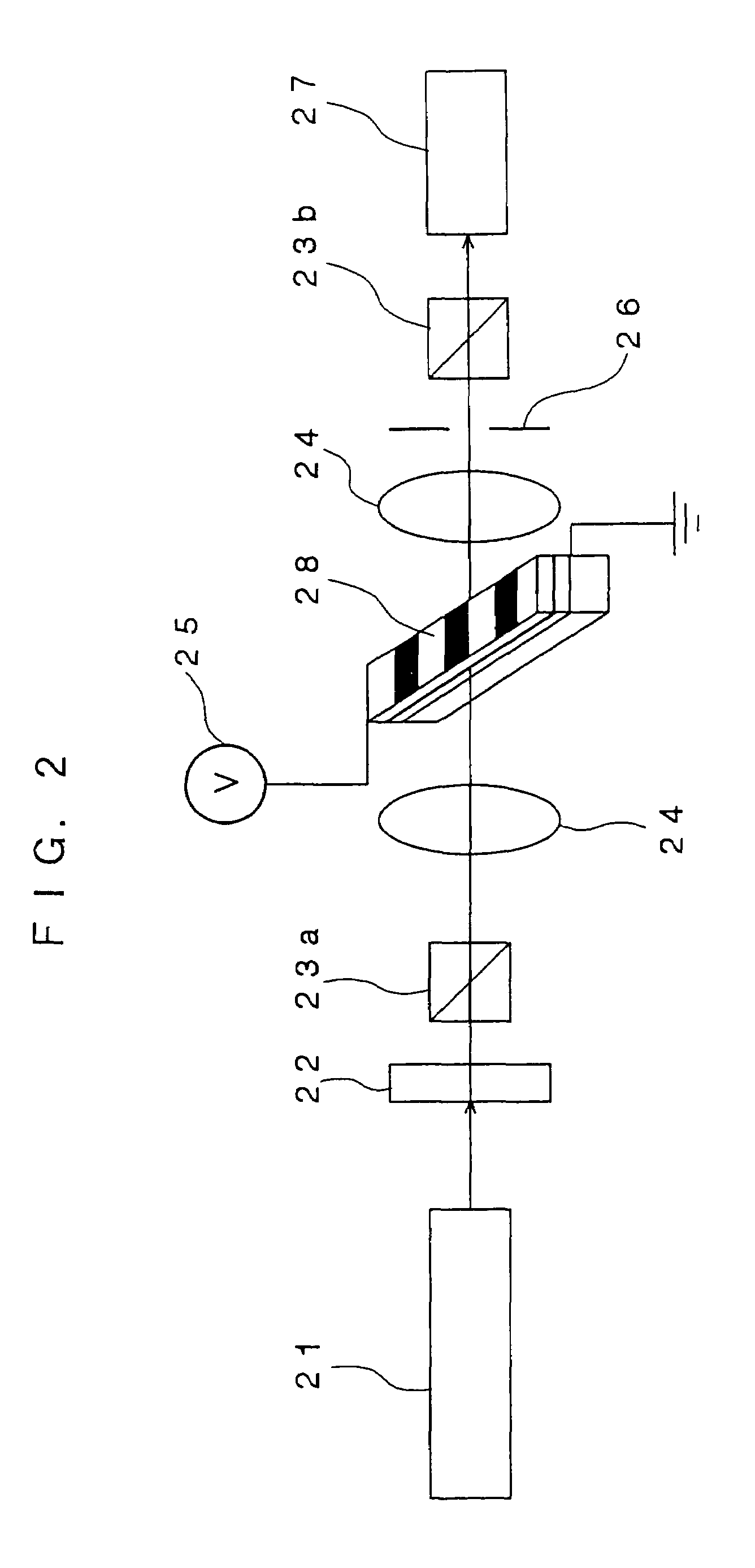Organic nonlinear optical material and nonlinear optical element using the same
a nonlinear optical material and organic technology, applied in the field of nonlinear optical elements, can solve the problems of difficult to manufacture a large amount of organic crystal that is necessary, fragile organic crystal, and damage to organic crystal, and achieve the effects of superior nonlinear optical performance, amorphous properties, and high glass
- Summary
- Abstract
- Description
- Claims
- Application Information
AI Technical Summary
Benefits of technology
Problems solved by technology
Method used
Image
Examples
example 1
Manufacture of Organic Nonlinear Optical Material
[0085]Three parts by mass of the following organic compound having nonlinear optical activity (sublimation temperature: ≧200° C.) which is a triarylamine derivative represented by formula (2) (tertiary amine derivative represented by formula (1) and having a partial structure of Z3-Lm including, from one terminal thereof to the other terminal, six unsaturated bonds that form one conjugated system, and 7 parts by mass of poly[Bisphenol A carbonate-co-4,4′-(3,3,5-trimethylcyclohexylidene)diphenol carbonate] (manufactured by Aldrich Corporationand and having a glass transition temperature of 200° C.) which is a polycarbonate are dissolved in 90 parts by mass of cyclopentanone (boiling point: 130° C.) to prepare a solution. The solution is applied to a glass substrate (2 cm×2 cm) having thereon a pair of parallel electrodes (distance therebetween: 20 μm) made of gold by a spin coating method. The resultant coating is dried at 130° C. for ...
example 2
Manufacture of Organic Nonlinear Optical Material
[0098]A thin film 2 including an organic nonlinear optical material that has been subjected to electric field poling is manufactured in the same manner as in Example 1 except that the organic compound having nonlinear optical activity used in Example 1 is replaced with an organic compound having nonlinear optical activity which has the following structural formula (A) and a sublimation temperature of 200° C. or more, and which is a tertiary amine derivative represented by formula (2) (a tertiary amine derivative represented by formula (1) and having a partial structure of Z3-Lm that has, from one terminal thereof to the other terminal thereof, six unsaturated bonds, except that polycarbonate serving as a polymer binder is replaced with polycycloolefin (Arton (trade name) manufactured by JSR Corporation, and having a glass transition temperature of 170° C.) represented by the following structural formula (B), and except that the poling...
example 3
Manufacture of Nonlinear Optical Element
[0107]An UV curable acrylic resin (NOA72 (trade name) manufactured by Norland) is applied to a glass substrate (2 cm×2 cm), on which an ITO electrically conductive film is formed as a lower electrode, by a spin coating method. The resultant coating is exposed to ultraviolet light (high-pressure mercury-vapor lamp manufactured by Ushio Inc.) at 100 mW / cm2 for 30 seconds and then heated at 120° C. for 30 minutes. Thus, a lower clad layer having a film thickness of 2 μm is formed.
[0108]Next, the solution containing polycycloolefin and the tertiary amine derivative that are employed in Example 2 is applied to the surface of the lower clad layer by a spin coating method and the resultant coating is dried at 120° C. for one hour to form a core layer having a film thickness of 2 μm. In addition, the same UV curable acrylic resin as the resin of the lower clad layer is applied to the surface of the core layer in the same manner as the lower clad layer...
PUM
| Property | Measurement | Unit |
|---|---|---|
| glass transition temperature | aaaaa | aaaaa |
| sublimation temperature | aaaaa | aaaaa |
| sublimation temperature | aaaaa | aaaaa |
Abstract
Description
Claims
Application Information
 Login to View More
Login to View More - R&D
- Intellectual Property
- Life Sciences
- Materials
- Tech Scout
- Unparalleled Data Quality
- Higher Quality Content
- 60% Fewer Hallucinations
Browse by: Latest US Patents, China's latest patents, Technical Efficacy Thesaurus, Application Domain, Technology Topic, Popular Technical Reports.
© 2025 PatSnap. All rights reserved.Legal|Privacy policy|Modern Slavery Act Transparency Statement|Sitemap|About US| Contact US: help@patsnap.com



